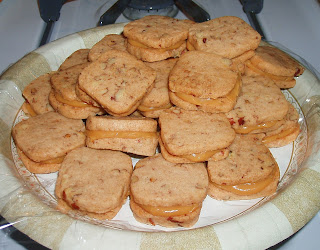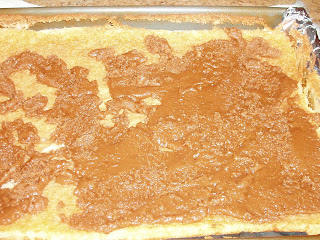So…..remember my regular harping about not liking to use nuts in baked goods? Well, forget about that for this post because in this recipe, nuts are a critical component that make it tasty. The original recipe calls for walnuts (hence the title) but my aversion to walnuts remain. Apparently I can’t change all my leopard-like spots at once. Not to knock walnuts but they’re too bitter for my taste. Pecans rule for this shortbread cookie. Toast the pecans first to bring out their flavor. The trick to toasting nuts? You have to rely on your sense of smell. You can time them but the best way to tell if the nuts are properly toasted is if they smell really good. That might seem frustratingly vague but try toasting nuts a few times and you’ll know what I mean. If you don’t toast them long enough, they’ll smell good but not really fragrant. If you have to stick your nose all the way into the pan to get the smell, then the nuts aren’t toasted enough. If you overtoast them, they’ll look and smell burnt. Depending on your oven, and if you want to be cautious, try toasting them for 7-10 minutes and keep checking if they should be toasted longer. But ultimately, follow your nose. Once the nuts are toasted, let them cool completely before you even start making the shortbread dough. If they’re even the slightest bit warm when you use them, they can melt your dough and you don’t want that. Plus it’s easier to chop them finely when they’re completely cool. I use my nut grinder to chop them up in less than 30 seconds. If you haven’t already, invest in a nut grinder. They’re less than $10 and will save you a lot of time.
These are the easiest shortbread cookies to make – the recipe is from the CIA (Culinary Institute of America) so it makes a lot but you can easily halve the recipe. The directions are pretty succinct but easy enough to follow. And you will need a food scale to measure the ingredients. My recipes from CIA are almost always based on weight, not volume since that's the most accurate measure. What I like about this recipe is the dough handles really well, i.e. it isn’t too sticky. Shape them into round or square logs, wrap them in wax paper and freeze them. When you’re ready to bake them, let the dough thaw slightly. If you cut the cookie logs while they’re too frozen, the dough will crumble. If you let it thaw too much, the dough may be soft and the log will start to lose its shape as you cut it. One trick I learned in culinary school is to keep turning the log as you make each slice so you can “re-shape” it back into the log instead of having one side flatten as you keep cutting.

The toasted pecans bring out a wonderful flavor to complement the buttery richness of the shortbread. Don’t underbake these (one of the few times you’ll see me write that) as the key to good shortbread is the “snap” of the cookie and you’ll only get that if you bake them long enough. I bake mine until the tops look a little dry and the underside is slightly golden brown. When they’re cool, they’re crisp without being hard. You can make these cookies plain and they make for tasty little tea cookies. However, this time around, I sandwiched these with a little dulce de leche. My parents just got back from South America and per my request (“PLEASE, Mom, all I want is dulce de leche”), they brought me back a couple of cans from Buenos Aires. I love dulce de leche. It goes really well with these cookies in terms of flavor and texture contrast. The only thing I would caution is you should put these together as a sandwich cookie at the very last minute before serving. Otherwise the filling (whether it’s dulce de leche or not) will soften the shortbread cookies over a few hours and you’ll lose the crispness and texture contrast. They’ll still taste good even if they’re not crisp but if you like the cookies crisp, wait until the last minute.
As the holidays approach, if you want some time-saving tips, make the dough ahead of time and wrap in wax paper before putting in the freezer, bake it the day you’re planning to serve it, put in airtight containers after they cool (Ziploc bags work really well) then sandwich them with the filling right before serving. This is also a good recipe to make with kids if you want a family activity since the dough is easy to put together, you just slice the cookie logs (no messing with flouring a cutting board, rolling out dough and cutting out cookies), and the kids can spread the filling and sandwich the cookies together.
Oh, and in case you’re not planning to go to South America any time soon, dulce de leche is available in the States. I’ve gotten the pricey jars at Williams Sonoma ($10 a jar - eek) but have been told they’re also available at Cost Plus World Market and I imagine they’re cheaper there. When my mom found that out, she wanted to know why I wanted her to bring dulce de leche back from South America when I could get it here. “But Mom, you were going to be in South America anyway….” Besides, I’d rather have dulce de leche than a t-shirt or a mug :).

1 lb soft butter
8 ozs brown sugar
1 lb, 4 ozs all-purpose flour
3 ozs cornstarch
1 teaspoon salt
2 teaspoons cinnamon
2 teaspoons vanilla
8 ozs walnuts, chopped
1. Cream butter and sugar. Sift dry ingredients together and add to the above. Add walnuts and vanilla to the batter; mix just until combined.
2. Shape dough into bricks. Refrigerate until firm. Slice ¼” thick, lay on paper.
3. Bake at 350˚F for ~15-18 minutes.










